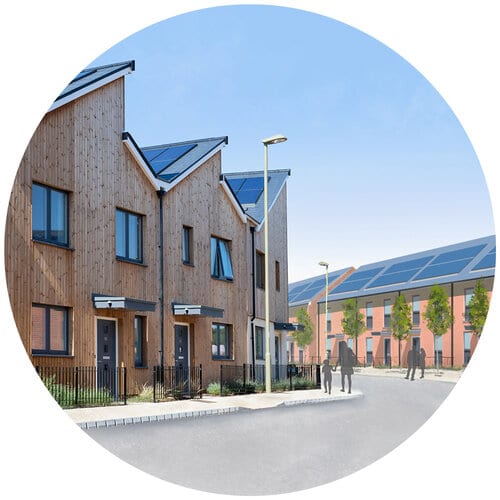The Committee on Climate Change (CCC) published an “over and above” cost for energy efficient new build of £4,800 [1]. However, many building professionals we speak to cannot replicate this figure when they are planning an EPC A new build. We took a closer look at the figure.
The CCC document references a study by Currie and Brown, in combination with AECOM [2], which examined the cost impacts of reducing space heating demand, alongside low-carbon heat uptake in a variety of domestic and non-domestic scenarios. The study examined different sources of low-carbon space heating and water including an Air Source Heat Pump (ASHP) and Low-carbon Heat Network (LCHN) against a traditional gas boiler.
For a semi-detached new build, built in 2020, the calculated additional capital costs of reducing the space heating demand to 15 kWh/m2/yr in combination with the use of an ASHP was estimated to be £4,800; this is relative to building a home to current standards with a gas boiler. A 3.9% increase on build cost is documented. The costing is reflective of typical national costs, of a medium housebuilder using traditional construction methods, using a reasonably efficient supply chain, design development, and construction process. However, the build cost is sensitive to a range of design and specification variables, economies of scale and regional variations and should be taken as indicative only.
So, how have they come to this?
- 15 kWh/m2/yr represents an ultra-high energy efficient building and have considered the packages of improvement measures that would be taken to meet the space heating demand including the walls, u-values of doors, ventilation, air permeability.
- The additional cost is divided into individual improvements in ventilation, air tightness, glazing and fabric cost.
- The future improvement in the systems efficiency has been incorporated into the models to recognise the ongoing refinement of technologies in new build.
- The distribution of the heat within the home has been considered. In a very energy efficient home, there is a low heating demand. The heating distribution pipework will be shorter and have a reduced number of radiators. A suggested 75% reduction in the cost of radiators and pipework can be expected in a home of 15 kWh/m2/yr.
The researchers used their own internal costing data within this study. However, ASHP installation is considered a cost-effective solution to low-carbon heat supply in new builds from 2021. The relative cost of these tighter standards and adopting a low-carbon heat network is expected to reduce over time.

We hope you found this article useful. If you would like either of the following, please get in touch:
How to include new build into your Roadmap to net zero
Satisfy yourself that the homes you build meet the designed energy efficiency
[1] “UK housing: Fit for the future?”, Committee on Climate Change, February 2019 https://www.theccc.org.uk/wp-content/uploads/2019/02/UK-housing-Fit-for-the-future-CCC-2019.pdf
[2] https://www.theccc.org.uk/wp-content/uploads/2019/07/The-costs-and-benefits-of-tighter-standards-for-new-buildings-Currie-Brown-and-AECOM.pdf for the full report.
